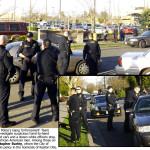England abandoned our Grand Jury process. Why shouldn’t Multnomah County?
We appreciate that concerns grow, nation-wide, for police accountability. We appreciate especially that communities are knitting together. When the President of the Portland/Beaverton Oregon Chapter of the National Action Network (NANPBO) brought up these concerns about the role of grand juries, we took note.
Our response:
The Grand Jury was originally a safeguard. Before the Crown could take action against a subject, his peers had to agree there were grounds for indictment. (Our former colonial oppressors have since abandoned the secret process.) The Grand Jury is not an open contest of facts. No judge oversees whether justice is done. It’s a directed, one-sided affair. It only determines whether a trial should convene.
Grand Juries are conducted by a county District Attorney, who generally works with law enforcement, to make cases against defendants. The process consistently fails when DAs are asked to indict their co-workers.
The Multnomah County DA released transcripts (cited here, we have them in our possession) of the case he presented against police officers who killed Keaton Otis. Analyzing them, you’ll find the prosecutor does not represent the victim, who has been silenced by homicide. He portrays officers as Boy Scouts, award winners, and in a most favorable light. Juries buy that. Eileen Barnes’ testimony, that the victim pleaded with her not to leave – that he feared cops would kill him – was followed by observations that she in the distant past had had a misdemeanor charge. (Portland Police do a poor job of tracking officer misconduct internally; it would be hard for a prosecutor to even produce evidence of prior bad conduct by an officer.)
The DA got a judge to open Otis’ juvenile records, protected by a previous court order. The dead man’s youthful shoplifting charge had nothing to do with the decision to pull him over; the ‘evidence’ was used to portray the victim as a criminal who needed killing. Officers were allowed to assert – unchallenged – that Otis “looked like a gangster.” Otis had no gang involvement: the coded message was that a young father was Driving while Black; slouching and, almost two years before Trayvon Martin, wearing a hoodie on a warm day in early May.
The DA does investigate, but only to impeach testimony outside the police narrative. S/he does not seek to build a case against cops.
The DA did present video footage of the fusillade which left Otis dead … but he asked Christina Lais, who documented the killing, to leave the room before presenting her evidence to the Grand Jury. It was always the contention of Fred Bryant (Otis’ father) that the prosecution muddled the audio: you and I can clearly hear Otis’ last words were likely: “I have my hands up! I have my hands up!” and that the command to open fire was “Let’s do it.”
In a purer pursuit of justice, lawyers represented James Chasse’s heirs in a civil trial (the result of a lawsuit, not a DA’s Grand Jury). It was by enhancing video of police comments after they dragged Chasse’s broken and dying body to a jail that refused to accept it for booking, that induced a jury to award damages to heirs and survivors.* In contrast, the county DA is not curious about anything which detracts from the police narrative of what happened. Police are not in the habit of enhancing evidence of their own misconduct.
The Grand Jury process is to be a stepping stone to criminal trial in open court. It is in that subsequent venue where conflicting evidence is tried before a judge or jury. It’s adversarial; someone actually speaks for the victim. However, DAs are using the Grand Jury process to prevent an open contest of the facts. The Grand Jury is supposed to be merely a ‘check in’ with The People. If there are two sides to the story, the case is supposed to go to trial … so we can find out who is lying.
In 2013 Consult Hardesty introduced three bills into the Oregon legislature. SB 779 (here) would require the state’s Attorney General “to appoint a lead investigator when police use deadly physical force. To try the case, the AG shall appoint an attorney not employed by the office of the district attorney in the county in which the incident occurred.”
Grand jury transcripts also demonstrate other techniques DAs employ, when they want to direct a jury to a certain outcome. They are called ‘leading questions.’
The State of Oregon offers a ‘stay out of jail’ clause. If an officer credibly testifies he was in fear for his life, he cannot be prosecuted for killing while on duty. In last month’s report (pg. 22) to the City of Portland, their consultants showed police also use a leading question in internal investigations. If an officer fails to invoke his protective clause, the IA interrogator will ask, “You were, at that point, in fear for your life, were you not?”
OIR declared, in City Council testimony, that they could not tell whether the officer under investigation actually held that belief, or was merely affirming that his interrogator did. UPDATE: OIR Group oral report on leading testimony here. “You were in fear for your life, weren’t you?”
A DA can, under current law, argue there is no reason for a Grand Jury to send a case to open trial. If the officer informs a Grand Jury (without being exposed to cross-examination) that he or she was in fear of her life, the DA can explain no trial is necessary.
We introduced SB 781 (at the link) to change that ‘stay out of jail’ standard, to allow a jury of our peers – at trial – to determine whether a reasonable person would share that officer’s fear, given the circumstances he or she (created or) found themselves in.
We also share the NANPBO President’s contentions: racial injustice has unbroken links to slavery times. Should the reader see Portland’s Gang ‘Enforcement’ Unit in action (right), they’ll understand these armed men as the modern equivalent of slave patrollers of old: the gang unit employs surprise, overwhelming numbers, and the threat of mortal harm, to suppress people of color in the pursuit of completely legal activity.
We contend it is much more important to film police interacting with people of color … than it is to ask cops to wear cameras pointed at The People. Perhaps, after a couple years of actually having processes in place – which discipline cops – we should begin to assess new surveillance devices.
*It should be noted that provisions in the plea deal struck in USA. v. City of Portland, to avoid trial for illegal use of force, are triggered when civil trials find police liable for misconduct. Importantly, Item 133 (pg. 48) requires PPB to “reevaluate the officer’s fitness to participate in all current and prospective specialized units,” and re-initiate an Internal Affairs investigation: “[PPB shall] identify whether any new evidence exists in the record of the civil trial to justify the reopening of the IA investigation …”


We extended our hand in organizational unity outreach and you accepted and connected with us to solidify our struggle to secure social, educational, economic, racial, criminal, and political justice for all.
Thank you Consult Hardesty!
NANPBO
Thank you!